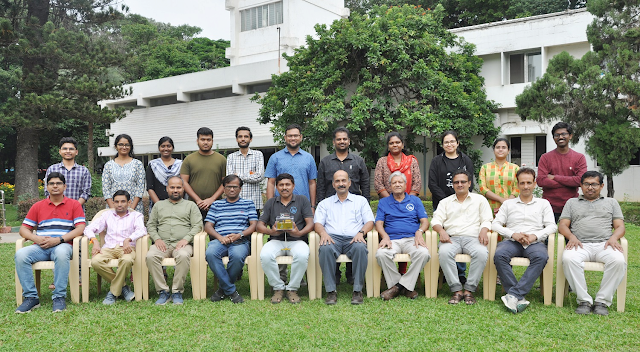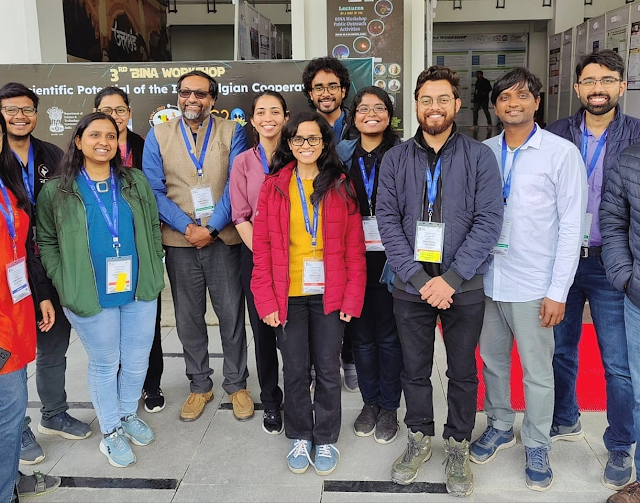
Aditya-L1, India's first observatory to study Sun, seeded in IIA - ISRO discussions to observe solar corona closely
- Visible Emission Line Coronagraph (VELC), the primary payload developed by IIA
- IIA & ARIES designed the first automated algorithm to detect CMEs on board Aditya-L1 using the VELC instrument
- Aditya-L1 support cell established at ARIES to act as community service centre for analyzing science data
India’s Aditya-L1, a space observatory with 7 payloads heading for a vantage point to study the Sun has started countdown for its journey. It had its beginnings in preliminary/initial discussions between the Indian Institute of Astrophysics (IIA) and Indian Space Research Organisation (ISRO) about possible observations of the solar corona using indigenous space based telescopes.
 |
Visible Emission Line Coronagraph (VELC)
 |
| VELC Engineering Team Members in front of the truck which had the VELC all packed and ready to go to ISRO |
IIA, an autonomous institute of the Department of Science and Technology (DST), had initially proposed a ‘suitable coronagraph’ payload to be mounted on a small satellite offered by ISRO. This ‘suitable coronagraph’ later graduated to the Visible Emission Line Coronagraph (VELC) and still prevails as the primary payload, even as India’s Solar study ambitions expanded, making it a national initiative with multi-institutional collaboration.
The VELC will image the Sun's atmosphere, the corona, closer to the Sun than ever before, at high resolution and time cadence. The payload has 40 different optical elements of high precision and will be kept at a temperature of 22 degrees celsius in space.
Led by IIA, the VELC was designed, assembled, characterised, tested and integrated at Centre for Research and Education in Science and Technology (CREST) campus in Hosakote and delivered in close collaboration with ISRO. A Clean Room of international standard (India's first large-scale “Class 10” Clean Room) was constructed for the purpose inside its MGK Menon Laboratory. ISRO made the mirrors and detectors and provided them to IIA, while IIA delivered the completed VELC to ISRO on 26 Jan 2023.
The VELC will image the Sun's atmosphere, the corona, closer to the Sun than ever before, at high resolution and time cadence. The payload has 40 different optical elements of high precision and will be kept at a temperature of 22 degrees celsius in space.
Led by IIA, the VELC was designed, assembled, characterised, tested and integrated at Centre for Research and Education in Science and Technology (CREST) campus in Hosakote and delivered in close collaboration with ISRO. A Clean Room of international standard (India's first large-scale “Class 10” Clean Room) was constructed for the purpose inside its MGK Menon Laboratory. ISRO made the mirrors and detectors and provided them to IIA, while IIA delivered the completed VELC to ISRO on 26 Jan 2023.
 |
| Faculty, students, postdocs in IIA who work on solar astrophysics |
 |
Since VELC observes the Sun closest to its surface, many other Aditya-L1 payloads also need its data about new coronal mass ejections and other eruptions. The VELC Payload Operations Centre (POC) set up in IIA campus, will receive raw data from ISRO Indian Space Science Data Centre (ISSDC) and process them further to make it suitable for scientific analysis.
The processed data will be sent back to ISSDC for dissemination. The scientific team at IIA will use the Aditya-L1 data from its many payloads in conjunction with field station observations on the ground to gain a deeper understanding of the Sun-Earth links and, more crucially, the space-weather impact.
Kodaikanal Solar Observatory and Gauribidanur Radio Observatory of IIA will play a key role in this.
This algorithm has been hard-coded by ISRO and will be used to detect CMEs automatically on board Aditya-L1, making it one of the first onboard intelligence algorithms for this purpose as no similar thing has been attempted in previous NASA or ESA missions studying the Sun.
This support cell will provide additional tools and train users about solar physics and provide help to understand, download and analyse the data from ISSDC/ISRO. AL1SC is conducting workshops in different parts of the country to familiarise students with the basic processes happening on the Sun, current open problems, the Aditya-L1 mission and observational data analysis.
The processed data will be sent back to ISSDC for dissemination. The scientific team at IIA will use the Aditya-L1 data from its many payloads in conjunction with field station observations on the ground to gain a deeper understanding of the Sun-Earth links and, more crucially, the space-weather impact.
Kodaikanal Solar Observatory and Gauribidanur Radio Observatory of IIA will play a key role in this.
Automated Algorithm To Detect Coronal Mass Ejections (CMEs)
IIA and Aryabhatta Research Institute of Observational Sciences (ARIES), an another institute of DST, designed an automated algorithm to detect CMEs (Coronal Mass Ejections) on board Aditya-L1 using the VELC instrument. This algorithm will be the first of its kind to track the huge bubbles of gas threaded with magnetic field lines that are ejected from the Sun, disrupting space weather and causing geomagnetic storms, satellite failures, and power outages. |
| Solar physics group at ARIES |
Aditya-L1 Support Cell (AL1SC)
ISRO has also collaborated with ARIES to establish the Aditya-L1 Support Cell at ARIES. The Aditya-L1 Support Cell (AL1SC) acts as a community service centre for the guest observers in preparing science observing proposals and analyzing science data.This support cell will provide additional tools and train users about solar physics and provide help to understand, download and analyse the data from ISSDC/ISRO. AL1SC is conducting workshops in different parts of the country to familiarise students with the basic processes happening on the Sun, current open problems, the Aditya-L1 mission and observational data analysis.







 IndianWeb2.com is an independent digital media platform for business, entrepreneurship, science, technology, startups, gadgets and climate change news & reviews.
IndianWeb2.com is an independent digital media platform for business, entrepreneurship, science, technology, startups, gadgets and climate change news & reviews.
ليست هناك تعليقات
إرسال تعليق